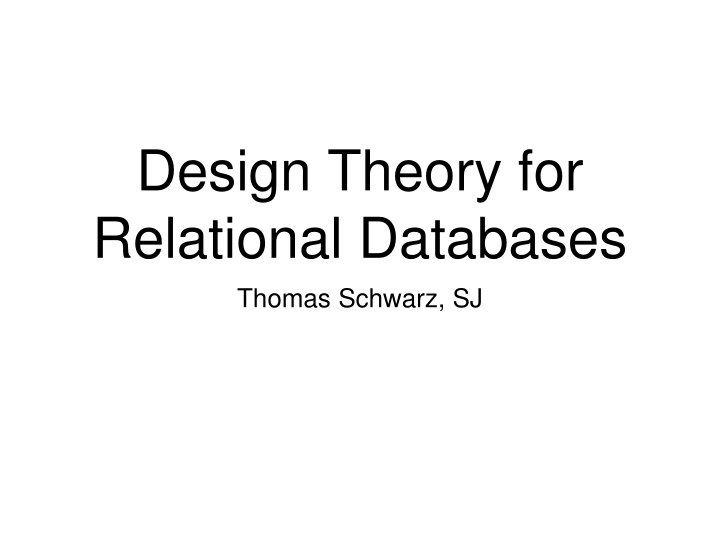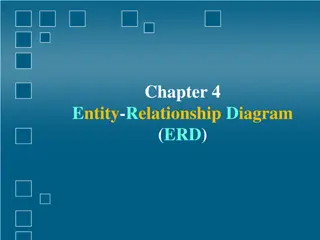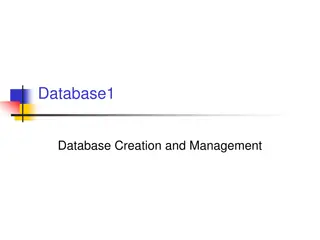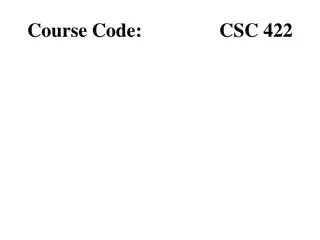
Efficient Database Design Theory
Database design theory is crucial for constructing well-organized database schemas. A well-designed scheme eliminates issues with constraint validation, data consistency, and performance. By applying functional dependencies and normal forms, anomalies and redundant data storage can be addressed effectively. Explore the fundamental concepts and examples of functional dependencies to grasp the essence of optimizing database structures.
Download Presentation

Please find below an Image/Link to download the presentation.
The content on the website is provided AS IS for your information and personal use only. It may not be sold, licensed, or shared on other websites without obtaining consent from the author. If you encounter any issues during the download, it is possible that the publisher has removed the file from their server.
You are allowed to download the files provided on this website for personal or commercial use, subject to the condition that they are used lawfully. All files are the property of their respective owners.
The content on the website is provided AS IS for your information and personal use only. It may not be sold, licensed, or shared on other websites without obtaining consent from the author.
E N D
Presentation Transcript
Design Theory for Relational Databases Thomas Schwarz, SJ
Contents There are many ways a database scheme can be constructed A poorly designed scheme: Has problems with checking constraints Has problems with data coherence E.g. two different spellings of the same person's first name Has problems with performance
Contents Design theory helps to design efficient schemes Functional dependencies Used in the definition of a key Used for flagging potentially bad records Normal forms Get rid of anomalies Get rid of redundant storage of data Expand to multivalued dependencies
Functional Dependencies A form of constraint for a relation Functional Dependency (FD) for table ?(?) FD ?1,?2, ?? ?1,?2, ,?? with ?1, ,??,?1, ,?? ? If a tuple's values agree for attributes ?1, ,?? Then they agree for attributes ?1,?2, ,??
Functional Dependencies Only consider FD with one attribute on the right Because FD ?1,?2, ?? ?1,?2, ,?? is equivalent to all of: ?1,?2, ?? ?1 ?1,?2, ?? ?2 ?1,?2, ?? ??
Functional Dependencies Example: Movies1( title, year, length, genre, studioName, starName) Find all FDs
Functional Dependencies title, year > length title, year > genre title, year > studio However: title, year starName is not an FD
Keys A superkey is a set of attributes in a table that determines all attributes ?(?1,?2, ??) ??1,??2, ??? is a superkey if ?:??1,??2, ??? ??
Keys A key is a minimal superkey with respect to set inclusion I.e. A superkey so that no attribute in it can be reomved If a key consists of a single attribute, then we call the attribute the key instead of the set with only element this attribute
Functional Dependencies Quiz: Given ?(?,?,?) and FDs ? ? and ? ?, Does this mean ? ??
Functional Dependencies Answer: Yes. Show that all tuples that agree on attribute A also agree on attribute C
Functional Dependencies A set ? of FDs follows from a set ? of FDs if every relation instance satisfying all FDs in T also satisfies all FDs in S Sets of FDs are equivalent if the set of relation instances satisfying one is equal to the set of relation instances satisfying the other one.
Functional Dependencies The splitting rule: ?1,?2, ?? ?1,?2, ,?? is equivalent to ?1,?2, ?? ?1 ?1,?2, ?? ?2 ?1,?2, ?? ??
Functional Dependencies The combining rule: The set of FDs ?1,?2, ?? ?1 ?1,?2, ?? ?2 ?1,?2, ?? ?? is equivalent to ?1,?2, ?? ?1,?2, ,??
Functional Dependencies Trivial FDs ?? ?? ?,? ? Trivial Dependency Rule: ?1?2 ?? ?1?2 ?? is equivalent to ?1?2 ?? ?1?2 ?? where the ?? are those of the ?? that are not among the ??
Functional Dependencies Closure: Let ? be a set of functional dependencies Let ? = {?1,?2, ,??} be a set of attributes The closure of ? is the set ?+ of attributes ? such that every relation that satisfies all the FDs in ? also satisfies ?1,?2, ,?? ?.
Functional Dependencies Closure calculation algorithm Input: a set of attributes ? and a set of functional dependencies ?. Output: ?+ 1. Split all FDs in ? so that there is only a single attribute on the right 2.Set ? to be ?. 3.Repeatedly search for some FD ?1,?2, ,?? ? ? such that ?1,?2, ,?? ? and ? ?. Then add ? to ? 4.Stop when the search fails and output ? = ?+.
Functional Dependencies Consider the relation scheme R = {E, F, G, H, I, J, K, L, M, M} and the set of functional dependencies {{E, F} -> {G}, {F} -> {I, J}, {E, H} -> {K, L}, K -> {M}, L -> {N} on R. What is the key for R?: {E,F} {E,F,H} {E,F,H,K,L} {E} Hint: calculate the closure of all possible answers
Functional Dependencies First, normalize {{E, F} -> {G}, {F} -> {I, J}, {E, H} -> {K, L}, K -> {M}, L -> {N} {{?,?} ?,{?} ?,{?} ?,{?,?} ?,{?,?} ?,? ?,? ?} Start with {?}. There is no FD that has only E on the left side
Functional Dependencies {{?,?} ?,{?} ?,{?} ?,{?,?} ?,{?,?} ?,? ?,? ?} Now try {?,?} = ? We can add G to ?. We can add I to ?. We can add J to ?. Then we are stuck: {?,?}+= {?,?,?,?,?}
Functional Dependencies {{?,?} ?,{?} ?,{?} ?,{?,?} ?,{?,?} ?,? ?,? ?} Now try {?,?,?} = ? We can add G to ? because of (1). We can add I to ? because of (2): ? = {?,?,?,?,?} We can add J to ? because of (3): ? = {?,?,?,?,?,?} (4) gives ? = {?,?,?,?,?,?,?} (5) gives ? = {?,?,?,?,?,?,?,?} (6) gives ? = {?,?,?,?,?,?,?,?,?} (7) gives ? = {?,?,?,?,?,?,?,?,?,?} Therefore {?,?,?}+ contains all the attributes. Since {?,?}+= {?,?,?,?}, {?,?,?} is a minimal candidate key and therefore a key.
Functional Dependencies Why does closure work Need to show equivalency of : ? {?1,?2, ,??}+ with regards to ? Every relation fulfilling ? fulfills ?1?2 ?? ?
Functional Dependencies Why does ? {?1,?2, ,??}+ with regards to ? imply Every relation fulfilling ? fulfills ?1?2 ?? ? Look at the first time adding an attribute to ? leads to an FD ?1?2 ?? ? that is not true. But ? was added using a FD ?1,?2, ?? ? Because this is the first time and ?1,?2, ?? follow from the ?1?2 ?? in all relations, ?1?2 ?? ?1, ?? Thus, a tuple equal in ?1?2 ?? is also equal in all ?1, ?? and hence equal in ?. Therefore ?1?2 ?? ? has to be true and we have a contradiction
Functional Dependencies Why does Every relation fulfilling ? fulfills ?1?2 ?? ? imply ? {?1,?2, ,??}+ with regards to ? Assume ? {?1,?2, ,??}+ with regards to ?, but ?1?2 ?? ? holds in all relations that also fulfill ?. Create a simple table: {A1 A2 ... An}+ every thing else 0 0 0 0 0 ... 0 0 0 0 1 1 ... 1
Functional Dependencies Does this instance satisfy ?? Assume an FD ?1?2 ?? ? in ? is violated For a violation to occur, the ?? need to be on the left side, i.e. in {?1,?2, ,??}+ and the ? on the right side of the table. {A1 A2 ... An}+ every thing else 0 0 0 0 0 ... 0 0 0 0 1 1 ... 1 But then we did not calculate the closure correctly and ? should have been in {?1,?2, ,??}+
Functional Dependencies Does this instance not satisfy ?1?2 ?? ? {A1 A2 ... An}+ every thing else 0 0 0 0 0 ... 0 0 0 0 1 1 ... 1 Yes!
Functional Dependencies Therefore the assumption is violated and this finishes the proof
Functional Dependencies With the closure calculation, we can prove If in a relation ??1,?2, ,?? ?1,?2, ,?? and ?1,?2, ,?? ?1,?2, ?? then ?1,?2, ,?? ?1,?2, ?? Transitivity
Functional Dependencies We sometimes have a choice in the minimal set of FDs that describe a relation A set of FD is called a basis if all FDs holding in the relation can be derived from the basis A minimal basis ?: All FDs in ? have singleton right sides Removing any FD from ? is no longer a basis If in any FD from ? we drop an attribute from the right side, then the result is no longer a basis
Functional Dependencies Example: A relation with three attributes such that each attribute determines the other attributes What are the FDs? Find a minimal basis
Functional Dependencies Answer: FDs are ? ?,? ? and all augmentations ? ?,? including the trivial ones ? ?,?, ? ?,? and? ?,?,? ? ?,? ? plus all augmentation ? ?, ? ? plus all augmentations
Functional Dependencies Answer: To obtain a bases, we can look at all subsets of right side singleton {? ?,? ?,? ?,? ?,? ?,? ?} For example: We try to remove from left ? ? follows from ? ? ? ? Left with {? ?,? ?,? ?,? ?,? ?}
Functional Dependencies Left with {? ?,? ?,? ?,? ?,? ?} Now can get rid of ? ? Left with {? ?,? ?,? ?,? ?}
Functional Dependencies Another possibility: {? ?,? ?,? ?}
Functional Dependencies Projecting Functional Dependencies Given a relation ? with a set of FDs ? and a subset ? of attributes of ?: What are the FDs induced in ??(?)? FDs can only involve attributes from ? But restricting ? to those is not enough
Functional Dependencies Algorithm: Start out with an empty set ? of FDs For each set ? of attributes ? calculate the closure ?+ in ? If ? ? is a FD calculated this way and ? ?, add the FD to ? Modify ? to become a minimal basis Remove all FDs that follow from others in ? Test whether an attribute on the left of a FD in ? can be removed
Functional Dependencies Example: ?(?,?,?,?) with ? = {? ?,? ?,? ?} projected on ? = {?,?,?} Calculate first closures {?}+= {?,?,?,?} {?}+= {?,?,?} {?}+= {?,?} {?}+= {?}
Functional Dependencies We really do not need any more because those with two attributes on the left would follow trivially Now we add the FDs derived from the closure, if all attributes are in ? ? = {? ?,? ?,? ?} This is not a base, because ? ? follows from the other ones. The induced FDs have base ? = {? ?,? ?}
Anomalies Take movies = (title, year, length, genre, studioName, starName) Redundancy : The studioName for Star Wars is repeated for every star This implies: Update anomaly : If we update the length of the movie, we need to repeat this update operation for every star or we get incoherent information Delete anomaly : If we delete all stars from an animation cartoon, we have no information left on the movie!
Decomposition Divide the information over two tables movies = (title, year, length, genre, studioName, starName) becomes movies1=(title, year, length, genre, studioName) movies2=(title, year, studioName)
Boyce Codd Normal Form Relation in BCNF if and only if: Whenever there is a non-trivial FD ?1 ?? ? then ?1 ?? is a superkey
Boyce Codd Normal Form Example Has FD but because of the star attribute, is not a key. We can decompose: Take the left side of the FD Calculate its closure Decompose into closure and right side movies1(title, year, length, genre, studio, star) title, year --> studio title, year {title, year}+ = {title, year, length, genre, studio} movies(title, year, length, genre, studio) starsIn(title, year, star)
Boyce Codd Normal Form What is good about BCNF? Update anomaly Decomposition prevents having to enter the same information multiple times Delete anomaly Can now have movies without stars Can we do better? Yes, sometimes. starsIn has still a two-attribute key
Boyce Codd Normal Form Any two attribute table ?(?,?) is in BCNF Proof by case distinction: Case 1: ? ?,? ? No nontrivial FDs exists, ? is in BCNF Case 2: ? ?,? ? ? is the only key and it is on the right of the only non-trivial FD. So BNCF. Case 3: ? ?, ? ? Same as before Case 4: ? ?,? ? Both ?,? are keys. So, BCNF
Boyce Codd Normal Form Decomposition: Does decomposition loose information or add spurious information? Does decomposition preserve dependencies How do we do decomposition
Boyce Codd Normal Form Finding decompositions Look for a non-trivial FD. If the right side is not a superkey: Expand the right side as much as possible ?1?2 ?? ?1 ?? Right side are all attributes that are dependent on ?1 ??
Boyce Codd Normal Form Example: with FD prod(title, year, studio, president, presAddr) title year -->studio studio --> president president --> presAddr Question: What are possible keys?
Boyce Codd Normal Form Only key is Just look at the closures of all subsets of attributes title, year Which FDs violate BCNF?
Boyce Codd Normal Form Two FDs: studio --> president president --> presAddr What happens with studio --> president
Boyce Codd Normal Form We calculate the closure of the right side studio --> president This gives a decomposition Using projection of FDs, we get so second relation is not in BCNF (studio is the only key) {studio}+ = {president, presAddr} (title, year, studio) (studio, president, presAddr) title, year -->studio studio --> president, president --> presAddr






















